Abstract
The Phenistix screening test for phenylketonuria in newborn infants, when used routinely at the recommended age of 4 to 6 weeks, passes as normal a substantial proportion—perhaps between a quarter and a half—of children with the disease, who are then diagnosed only after brain damage has occurred. Screening procedures based on three other tests—namely, the paper chromatography test for o-hydroxyphenylacetic acid in urine, the Guthrie test for phenylalanine in blood, and a modification of the Guthrie test for phenylalanine in urine—have been compared with each other and with the Phenistix test in a special field inquiry. Each of the three tests is more efficient than the Phenistix test for the detection of phenylketonuria at an early age.
A full appraisal indicates that the Guthrie test on blood would be the most satisfactory of the three tests to replace the Phenistix test as a screening procedure. Routine use of this would involve comprehensive arrangements for obtaining a single specimen of blood by heel-prick from every newborn infant at the age of 6 days or more, but preferably not later than 14 days, and for the rapid and economical processing of the specimens and skilled interpretation of the results at a few laboratory centres. These requirements have not proved difficult to meet in practice in the area where this procedure has been studied.
A positive screening test result does not signify a firm diagnosis of phenylketonuria, but is an indication for fuller investigation, most suitably at one of a small number of centres specializing in the management of phenylketonuria and other inborn errors of metabolism.
Full text
PDF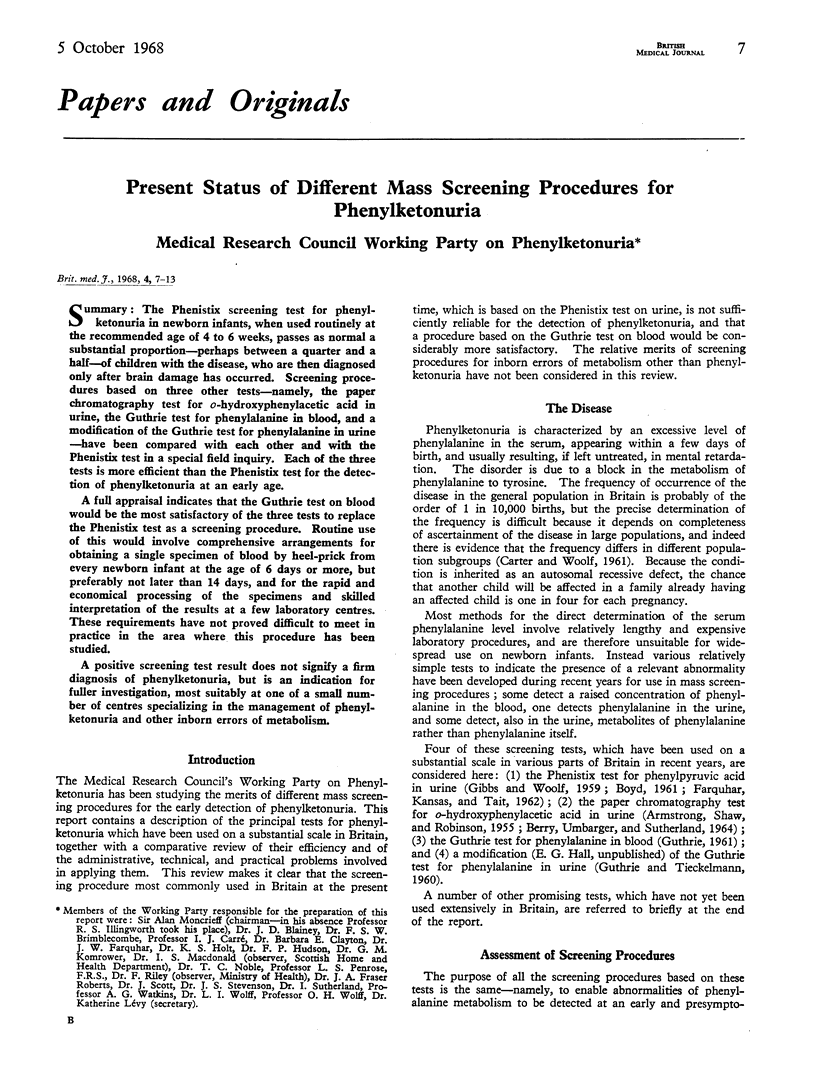
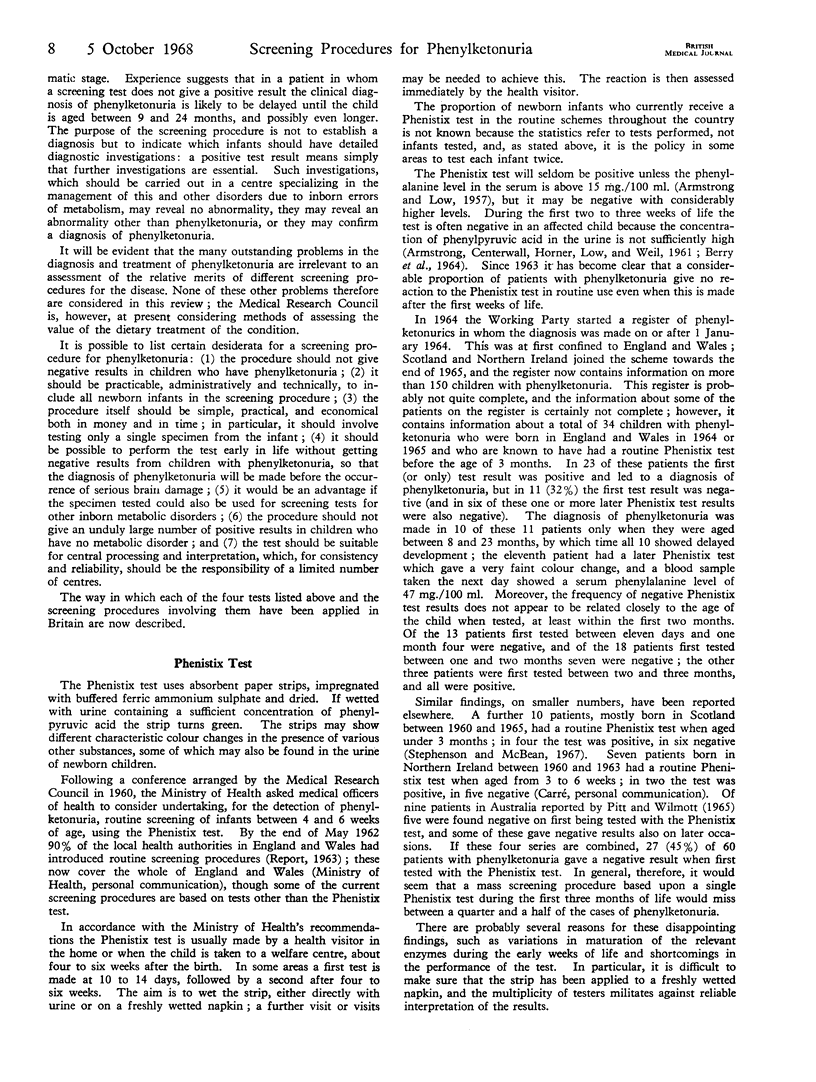
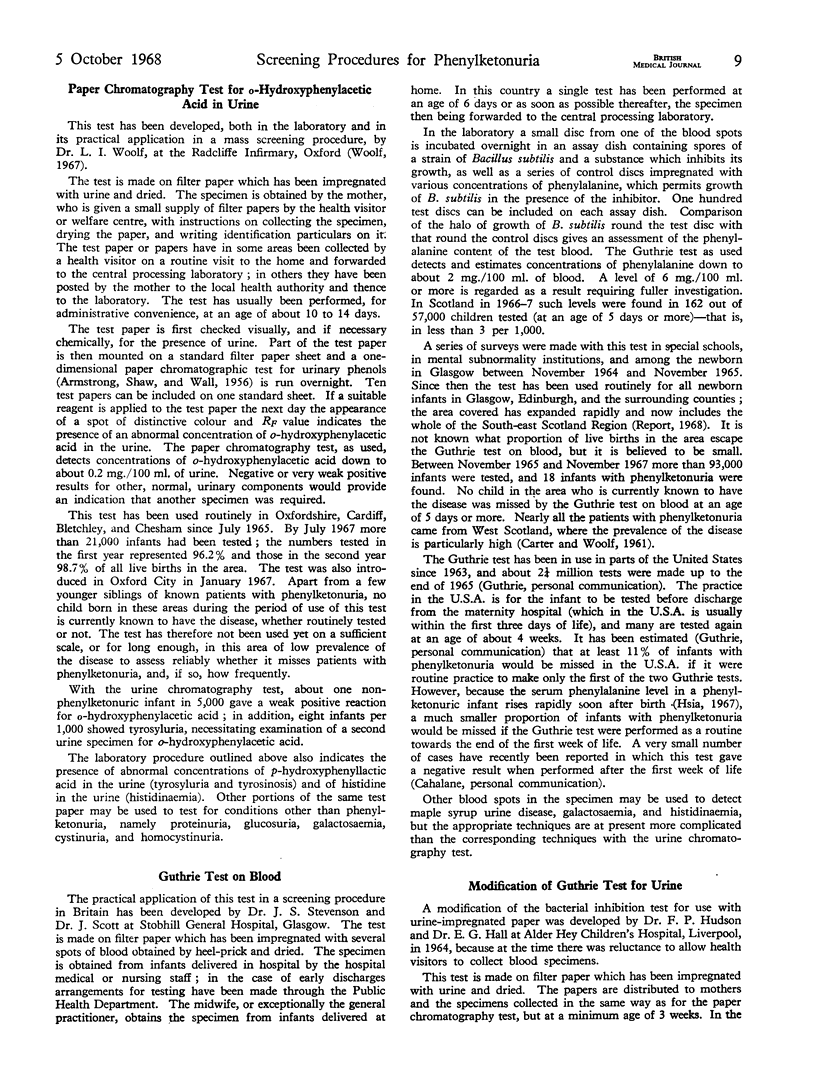
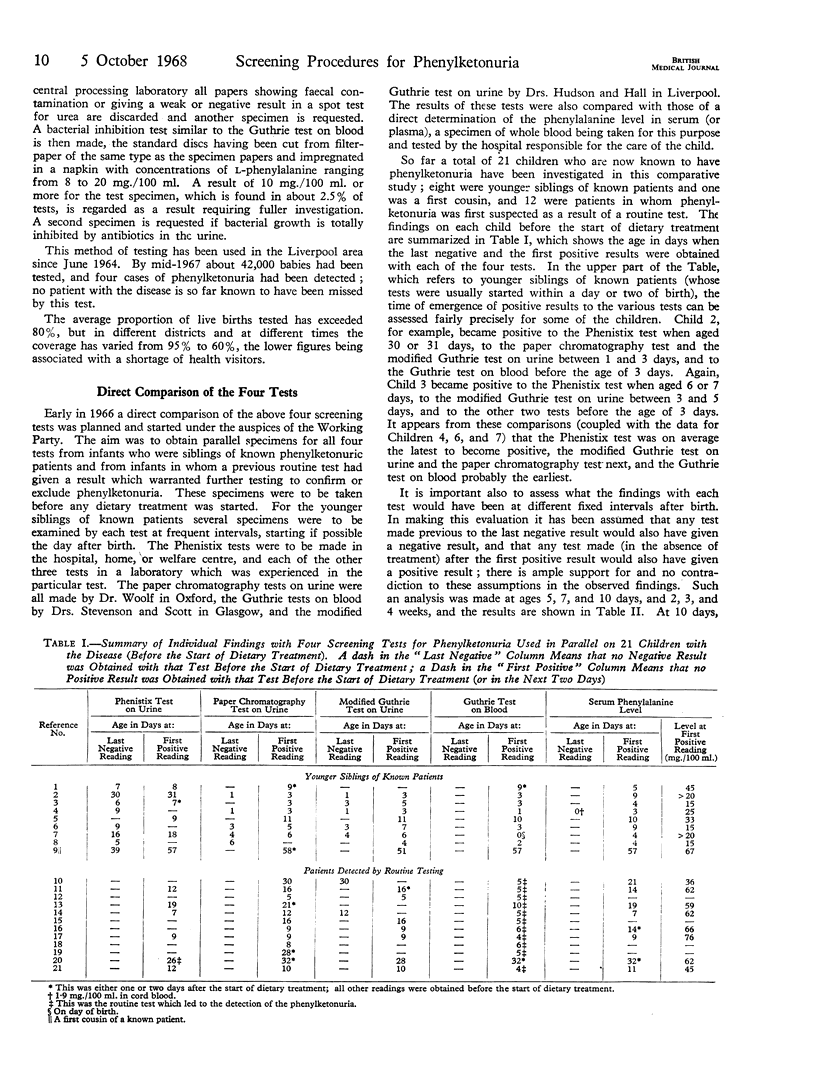
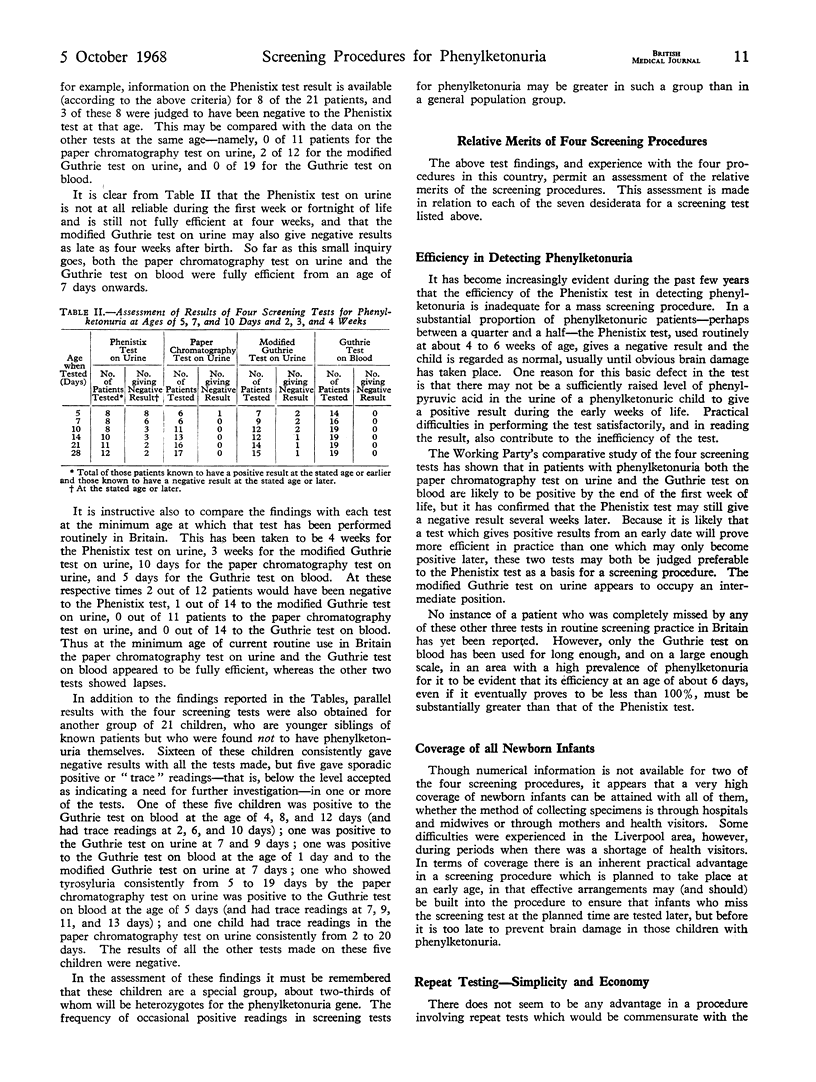
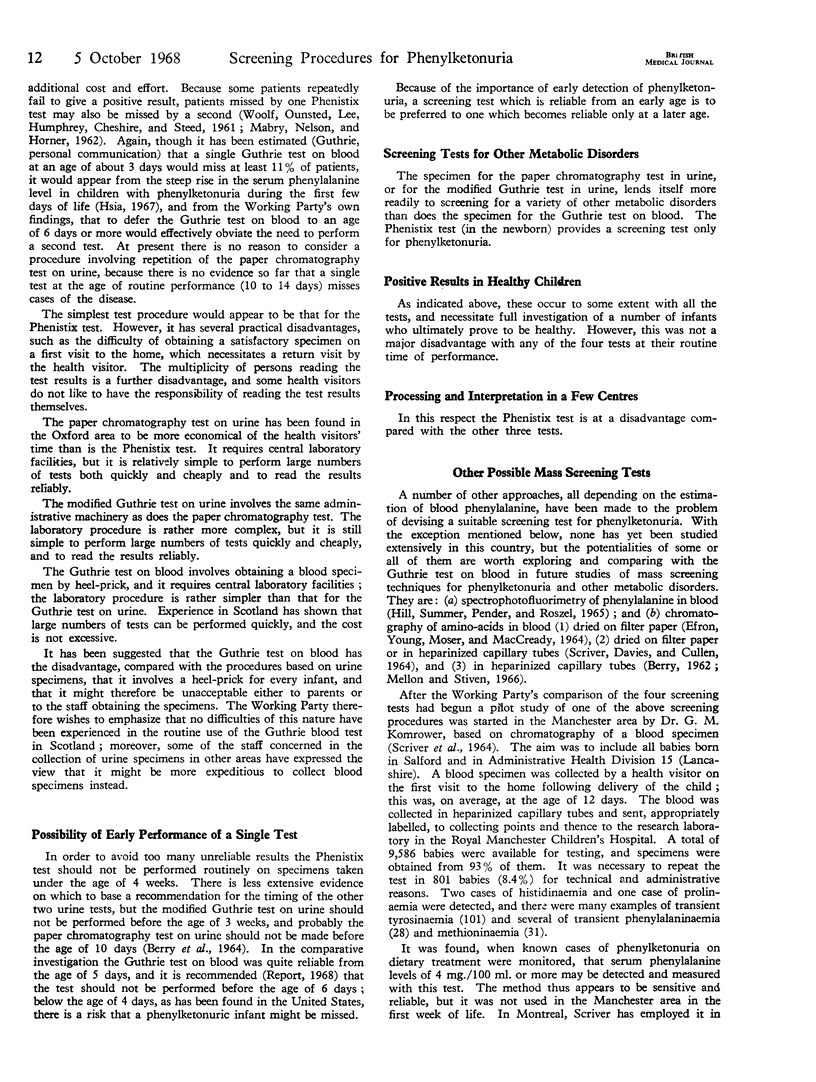
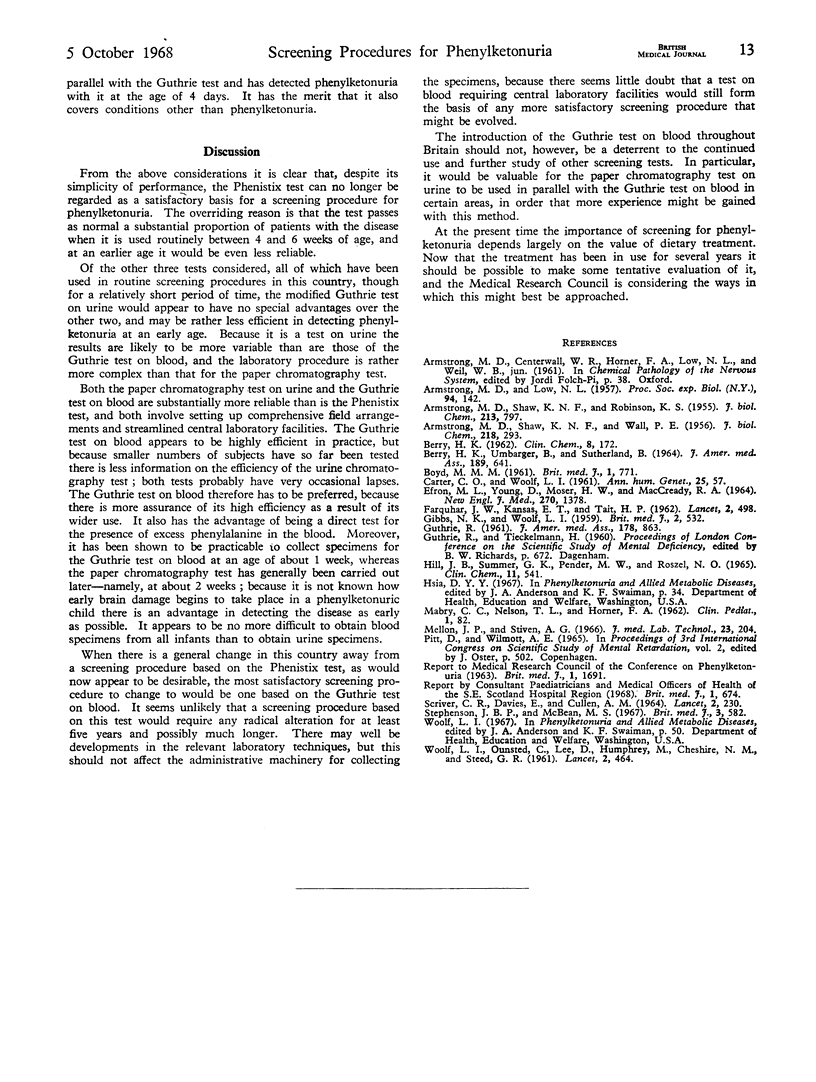
Selected References
These references are in PubMed. This may not be the complete list of references from this article.
- ARMSTRONG M. D., LOW N. L. Phenylketonuria VIII. Relation between age, serum phenylalanine level, and phenylpyruvic acid excretion. Proc Soc Exp Biol Med. 1957 Jan;94(1):142–146. doi: 10.3181/00379727-94-22880. [DOI] [PubMed] [Google Scholar]
- ARMSTRONG M. D., SHAW K. N., ROBINSON K. S. Studies on phenylketonuria. II. The excretion of o-hydroxyphenylacetic acid in phenylketonuria. J Biol Chem. 1955 Apr;213(2):797–804. [PubMed] [Google Scholar]
- ARMSTRONG M. D., SHAW K. N., WALL P. E. The phenolic acids of human urine; paper chromatography of phenolic acids. J Biol Chem. 1956 Jan;218(1):293–303. [PubMed] [Google Scholar]
- BERRY H. K., UMBARGER B., SUTHERLAND B. TESTING OF NEWBORN SIBLINGS IN PHENYLKETONURIC FAMILIES. JAMA. 1964 Aug 24;189:641–642. doi: 10.1001/jama.1964.03070080047018. [DOI] [PubMed] [Google Scholar]
- BERRY H. K. Use of micromethod for phenylalanine in management of phenylketonuric patients. Clin Chem. 1962 Apr;8:172–173. [PubMed] [Google Scholar]
- CARTER C. O., WOOLF L. I. The birthplaces of parents and grandparents of a series of patients with phenylketonuria in in south-east England. Ann Hum Genet. 1961 May;25:57–64. doi: 10.1111/j.1469-1809.1961.tb01497.x. [DOI] [PubMed] [Google Scholar]
- EFRON M. L., YOUNG D., MOSER H. W., MACCREADY R. A. A SIMPLE CHROMATOGRAPHIC SCREENING TEST FOR THE DETECTION OF DISORDERS OF AMINO ACID METABOLISM. A TECHNIC USING WHOLE BLOOD OR URINE COLLECTED ON FILTER PAPER. N Engl J Med. 1964 Jun 25;270:1378–1383. doi: 10.1056/NEJM196406252702602. [DOI] [PubMed] [Google Scholar]
- FARQUHAR J. W., KANSAS E. T., TAIT H. P. Problems of routine screening for phenylketonuria. Lancet. 1962 Sep 8;2(7254):498–500. doi: 10.1016/s0140-6736(62)90358-6. [DOI] [PubMed] [Google Scholar]
- GIBBS N. K., WOOLF L. I. Tests for phenylketonuria: results of a one-year programme for its detection in infancy and among mental defectives. Br Med J. 1959 Sep 26;2(5151):532–535. doi: 10.1136/bmj.2.5151.532. [DOI] [PMC free article] [PubMed] [Google Scholar]
- HILL J. B., SUMMER G. K., PENDER M. W., ROSZEL N. O. AN AUTOMATED PROCEDURE FOR BLOOD PHENYLALANINE. Clin Chem. 1965 May;11:541–546. [PubMed] [Google Scholar]
- MABRY C. C., NELSON T. L., HORNER F. A. Occult phenylketonuria. Clin Pediatr (Phila) 1962 Nov;1:82–86. doi: 10.1177/000992286200100117. [DOI] [PubMed] [Google Scholar]
- Mellon J. P., Stiven A. G. A rapid method for the detection of plasma phenylalanine. J Med Lab Technol. 1966 Jul;23(3):204–206. [PubMed] [Google Scholar]
- SCRIVER C. R., DAVIES E., CULLEN A. M. APPLICATION OF A SIMPLE MICROMETHOD TO THE SCREENING OF PLASMA FOR A VARIETY OF AMINOACIDOPATHIES. Lancet. 1964 Aug 1;2(7353):230–232. doi: 10.1016/s0140-6736(64)90183-7. [DOI] [PubMed] [Google Scholar]
- Stephenson J. B., McBean M. S. Phenylketonuria: a reassessment of mass infant screening by napkin test. Br Med J. 1967 Sep 2;3(5565):582–582. doi: 10.1136/bmj.3.5565.582. [DOI] [PMC free article] [PubMed] [Google Scholar]
- WOOLF L. I., OUNSTED C., LEE D., HUMPHREY M., CHESHIRE N. M., STEED G. R. Atypical phenylketonuria in sisters with normal offspring. Lancet. 1961 Aug 26;2(7200):464–465. doi: 10.1016/s0140-6736(61)92434-5. [DOI] [PubMed] [Google Scholar]


